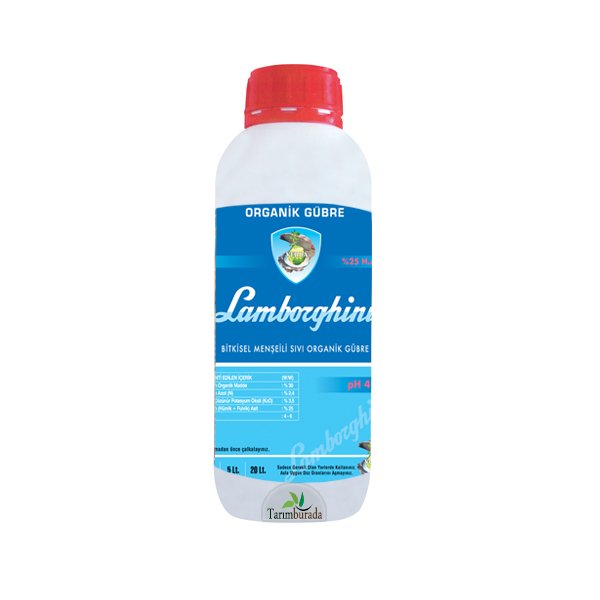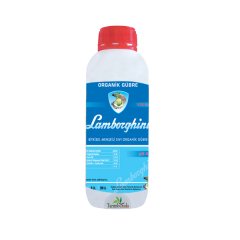Lamborgini - Liquid Humic and Fulvic Acid 1 Liter
Liquid Humic Acid: Organic Soil Regulator: Lamborgini liquid humic acid regulates the physical, chemical and biological properties of the soil. It increases the organic matter level of the soil. It ensures the germination of seeds and the rooting of seedlings. It plays an active role in creating healthy, strong and durable vegetative parts. It prevents the formation of a creamy layer in the soil. It swells the soil, aerates it and increases its water retention capacity perfectly. It provides nutrients to plants by transforming chemical residues in the soil into useful norms.
Lamborghini 25% is an organic fertilizer. It is completely organic and obtained entirely from herbal sources. In this way, it is completely absorbed by the plant. Humic acids originating from Leonardite work in the soil, they cannot enter the plant body. Lamborghini 25% works both in the soil and within the plant. Fulvic acids are much more active than humic acids. They play an active role in the transport of plant nutrients in the soil and within the plant and chelate plant nutrients. Fulvic acids disappear from the soil quickly because they enter the plant body and are much more active than humic acids. There is a visible difference when used from leaves and soil. It ensures the formation of chlorophyll, allowing plants to turn greener. It increases photosynthesis. Provides increased efficiency. It increases the sugar amount of fruits and vegetables. It ensures the formation of quality fruits, increases respiration and protein synthesis in the plant. It increases the gluten content in wheat and improves bread quality. It facilitates the transport of plant nutrients between tissues. Fulvic acids: It is a part of humic substances that are water-soluble under all pH conditions. The colors of fulvic acids are light yellow yellow brown. Fulvic acid is called "nature's miraculous molecule" because of its countless positive functions on soil and plants.
Herb | Application Time | Recommended Dosage |
Cereals | Tillering (with herbicide) | 150 - 250 |
Sugar Beet - Potato | 1)After the first hoe (3-5 leaves), 2)After the Second Anchor | 250 - 400 250 - 400 |
Strawberry | 1) During tillering and fruit setting period | 250 - 400 |
Sweetcorn | 1)After the first anchor 2)After the second anchor | 250 - 400 250 - 400 |
Cotton | 1)When it grows 8 - 10 cm tall 2)15 - 20 days after the first | 250 - 400 250 - 400 |
Tobacco | 1) After planting, extract it from the soil with its life water. 2) In the 3-leaf period | 250 - 400 250 - 400 |
Sunflower | 1) When the plants have 4 - 5 leaves 2)Between the first and second anchor | 250 - 400 250 - 400 |
Beans, Chickpeas, Cumin Other Legumes | 1)When the plants are about 10cm 2)15 - 20 days after the first | 250 - 400 250 - 400 |
in the vineyards | 1)Before flowering 2)After cluster formation | 250 - 400 250 - 400 |
Hazelnuts - Pistachios | 1)Leaf in mouse ear 2)In fruit formation | 250 - 400 250 - 400 |
Apple pear | 1)After fruit set 2)Give at least two applications, 20 days apart from the first, for each application. | 250 - 400 250 - 400 |
Plum, Cherry, Sour Cherry, Peach Olive | 1)After fruit set 2)Give at least two applications, 20 days apart from the first, for each application. | 250 - 400 250 - 400 |
Orange, Lemon, Tangerine Grapefruit | 1)After fruit set 2)Give at least two applications, 20 days apart from the first, for each application. | 250 - 400 250 - 400 |
Greenhouse Vegetables | When it has 6 - 7 leaves, at least three applications with 20-day intervals starting from the first application and each time. | 250 - 400 |
Field Vegetables: Tomato, Pepper, Eggplant, Cucumber, Lettuce | Starting from the 6 - 7 leaf stage, at least two applications with 20 days intervals and each time. | 250 - 400 |



